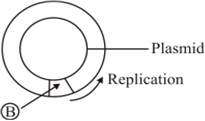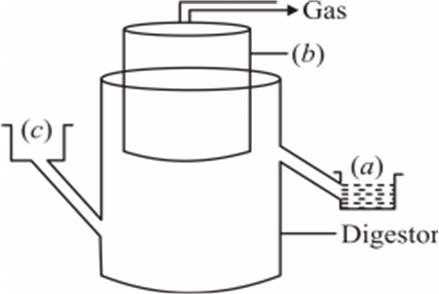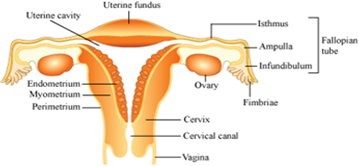 Short Answer Type
Short Answer TypeThe base sequence in one of the strands of DNA is TAGCATGAT.
(i) Give the base sequence of its complementary strand.
(ii) How are these base pairs held together in a DNA molecule?
(iii) Explain the base complementarity rules. Name the scientist who framed this rule.
(a) Sickle celled anaemia in humans is a result of point mutation. Explain.
(b) Write the genotypes of both the parents who have produced a sickle celled anaemic offspring.
(a) Identify (A) and (B) illustrations in the following:
i. 
ii. 
(b) Write the term given to (A) and (C) and why?
(c) Expand PCR. Mention its importance in biotechnology.

The diagram above is that of a typical biogas plant. Explain the seQ uence of events occurring in a biogas plant. Identify a, b and c.
How can crop varieties be made disease resistant to overcome food crisis in India? Explain.
Name one disease resistant variety in India of:
(a) Wheat to leaf and stripe rust
(b) Brassica to white rust
Write the source and the effect on the human body of the following drugs:
(i) Morphine
(ii) Cocaine
(iii) Marijuana
Name the type of interaction seen in each of the following examples:
(i) Ascaris worms living in the intestine of human
(ii) Wasp pollinating fig inflorescence
(iii) Clown fish living among the tentacles of sea-anemone
(iv) Mycorrhizae living on the roots of higher plants
(v) Orchid growing on a branch of a mango tree
(vi) Disappearance of smaller barnacles when Balanus dominated in the Coast of Scotland.
 Long Answer Type
Long Answer Type(a) Draw a labelled diagram of the human female reproductive system.
(b) Enumerate the events in the ovary of a human female during:
(i) Follicular phase
(ii) Luteal phase of menstrual cycle
(a) 
(b)
(i) Follicular phase: Follicular phase is also called the proliferative phase. During this phase the FSH released by the pituitary stimulates the growth of the primary ovarian follicle and also causes maturation of the primary oocyte in this follicle. The follicular cells of the Graafian follicle secrete oestrogen. Due to an increase level of estrogen the uterine endometrium becomes thick, more vascular and more glandular. This phase lasts for about 10 to 14 days, or until ovulation occurs. The luteinizing hormone (LH) released by the pituitary induces the mature Graafian follicle to burst and release the egg or ovum into the fallopian tube. This is called ovulation.
(ii) Luteal phase: The luteal phase is also called secretory phase or the post -ovulatory phase. It follows the ovulation. During this phase the corpus luteum continues to release the hormone, progesterone. It lasts for about 12 - 14 days and extends from the 16th - 28th day of the menstrual cycle.
